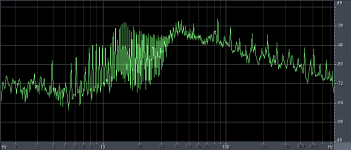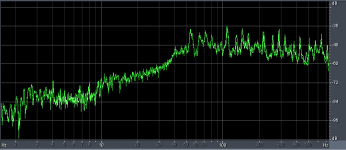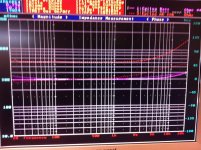The modern definition of chaos implies emergent properties, a "structure" within the process observed. True randomness closely observed includes only more randomness on all scales, turtles all the way down.
Thanks,
Chris
Thanks,
Chris
Some of these types of rounding errors had nasty consequences:
Computer Arithmetic Tragedies page of Kees Vuik
Cheers,
ZAP
And, the processors do this in-flight ! The supercomputers at LLNL often run over night at their max speed doing calculations for hours on codes. The end results may be just a few digits change or a few added decimal places. But it must give the same number every time the calc are done. In the case, i decribed, the slower machine was more consistant but the researchers could not get the extra places they needed.
THx-RNMarsh
Last edited:
HTML:
, , , , , , , , , ,
</ \> \> </ </ </ \> </ </ \>
|| || || || || || || || || ||
|| || || || || || || || || ||
|| || || || || || || || || ||
((@))((@))((@))((@))((@))((@))((@))
((@))((@))((@))((@))((@))((@))((@))
{ _ _ }
{ |_||\ |_)|_)\/ }
{ | ||-\| | / }
{ _ _ ___ _ }
{ |_)||_) | |_|| \|\ \/ }
{ |_)|| \ | | ||_/|-\/ }
{ }
((@))((@))((@))((@))((@))((@))((@))((@))((@))
((@))((@))((@))((@))((@))((@))((@))((@))((@))
{ }
{ }
{ _ }
{ |/ \|_||\ | }
{ (_|\_/| || \| }
{ }
{ }
{ }
((@))((@))((@))((@))((@))((@))((@))((@))((@))
(jgs)((@))((@))((@))((@))((@))((@))((@))((@))A simulation with rounding errors could be considered chaotic. It may be attempting to simulate a chaotic system. These two systems, reality and simulation, may show different chaotic behaviour as the simulation is not the same as the real system.
Some of these types of rounding errors had nasty consequences:
Computer Arithmetic Tragedies page of Kees Vuik
Cheers,
ZAP
Wow! I would have been rich if it wasn't for rounding errors 😎
Jan
Hey jan..
Still workin the article.
Had to go through most of the IR hexfet line to characterize the thermal resistance of their products. I'm finding some really interesting things.
jn
Still workin the article.
Had to go through most of the IR hexfet line to characterize the thermal resistance of their products. I'm finding some really interesting things.
jn
Which is then down to the particular implementation of Spice, how many bits are used for floating point. Nice thing with computing, is that one can always add more grunt when needed - downside is that results take longer to come out, but this is an issue that steadily improves, year by year ...
No one would bother with less than 64 bit floats about -300dB rounding floor.
I would like to report that analog design is still alive and well, even though some of its most famous designers have passed away. The 'Analog Aficionados' event was brim full of both younger and older analog designers, some even older than me! And the conversation was brisk with notepads open and people sharing circuits there.
From the DIY people sometimes here, both Ron Quan and Kirkwood Rough were there big time, sharing their thoughts and opinions along with everyone else.
Kirkwood showed me a very interesting circuit that he had some problems with. I told him that he was 'nuts' to even attempt that design. '-) Ron reminded me that there really was a difference between PIM and FM distortion measurement, although I suspect that they both come from the same distortion mechanism.
There were lots of interesting people there, some really, really sharp.
The event was sponsored by Linear Systems, the fet source for DIY. Their work is progressing and their yields are increasing, leaving the future of complementary differential jfet input stages both possible and even 'improvable' with newer devices in future. Personally, I would rather go to this event than any other in the Bay Area. Of course, that's me, not most audio amateurs.
From the DIY people sometimes here, both Ron Quan and Kirkwood Rough were there big time, sharing their thoughts and opinions along with everyone else.
Kirkwood showed me a very interesting circuit that he had some problems with. I told him that he was 'nuts' to even attempt that design. '-) Ron reminded me that there really was a difference between PIM and FM distortion measurement, although I suspect that they both come from the same distortion mechanism.
There were lots of interesting people there, some really, really sharp.
The event was sponsored by Linear Systems, the fet source for DIY. Their work is progressing and their yields are increasing, leaving the future of complementary differential jfet input stages both possible and even 'improvable' with newer devices in future. Personally, I would rather go to this event than any other in the Bay Area. Of course, that's me, not most audio amateurs.
No one would bother with less than 64 bit floats about -300dB rounding floor.
When I play with MathCad the numerical noise is about -320dB.
Jan
When I play with MathCad the numerical noise is about -320dB.
Jan
Numerical resolution can be turned into an academic curiosity but it does not figure into day to day SPICE results. Folks used to make a big deal about the Motorola 80 bit floats vs. Intel 64 bit floats by inverting nearly singular matrixes with one vs. the other, mostly nerd games.
Hi John;
I sent you pm with my address. The concert starts at 7pm this Saturday, February 15.
Here is the guy:
Paganini Sonata Andrei Krylov guitar - YouTube
I sent you pm with my address. The concert starts at 7pm this Saturday, February 15.
Here is the guy:
Paganini Sonata Andrei Krylov guitar - YouTube
The event was sponsored by Linear Systems, the fet source for DIY. Their work is progressing and their yields are increasing, leaving the future of complementary differential jfet input stages both possible and even 'improvable' with newer devices in future. Personally, I would rather go to this event than any other in the Bay Area. Of course, that's me, not most audio amateurs.
So J-fets still on the table for the foreseeable future .. ... 🙂
Hey jan..
Still workin the article.
Had to go through most of the IR hexfet line to characterize the thermal resistance of their products. I'm finding some really interesting things.
jn
Hey Inductive man, whats causing the rise, too much mass or too low a BL..
Attachments
Last edited:
So J-fets still on the table for the foreseeable future .. ... 🙂
The "newer devices" is a stretch. K170/J74 is about all we will ever see, paralleling them on one die has limited possibilities. The IRF3600 devices are essentially massively parallel smaller transistors with rersultant huge capacitances for a given gm.
The LS489 will have a complement soon. And let's get real about semiconductors. Depletion mode jfets are one of the most ideal devices for audio design.
Last edited:
The LS489 will have a complement soon. .
Holes and electrons are not going anywhere, there could be a complement but no more than in the K170/J74 sense.
Of course, IC designers cannot easily use complementary jfets in their designs, but I certainly win awards by designing with them, and many other audio designers use the same devices, and they win awards too!
I will rely on my personal experience, thank you, on this.
Right now I just started playing a pristine direct disc vinyl recording 'The Missing Linc' from Sheffield records in the 70's. Wow! And better to come when I improve my system even more.
Of course I am using my own electronics thru-out.
The $30,000 speaker set-up doesn't hurt at all, but we have known for more than 40 years that you cannot equate static speaker distortion specs with distortion from electronics. This is what I do for a living---try to make sense of it all. This cannot be matched or better by any digital source that I can muster.
This one's been quoted a few times.
It appears your definition of quality is a personal experience. No room for advancements here. Everybody's definition of quality becomes their own experience. Yuck.
Sure, you can make a tape free, digital free one take recording direct to cutter. Modulation distortions of tape and digital are gone, leaving distortions of cutter system, and those of pickup system.
In vast majority of phonograph recording pickup systems, freely pivoting tonearm with mass orders of magnitude greater than stylus and cantilever system of cartridge, also with relatively high mass is used. Stylus provides both desired signal of recording, and groove pitch signal from cutting lathe. Cantilever suspension must deal with both. Modulation distortion is rampant.
Once in a while, somebody posts a recording made from phonograph. Here are two examples:

And:

For comparison, a CD track with characteristics similar to numerous CD recordings I've looked at:

Low frequency resonance of phonograph players is gross.
Speaker drivers do similar transformations, but require sparser spectrum such as two tone, with at least one of the tones close to driver resonance to see what is happening, and correlate it with what is heard.
In case of phonograph players, once the correlation is made by a listener of IM effects, the turntable mostly stops spinning. Others revel in the IM effect, and its exacerbation of similar effects in speaker drivers.
Once again, with a DUT when all other variables are held constant, they may individually all be of dubious characteristics, yet reveal audible difference in test devices.
Your are electronics artist, well versed in your medium, but ignore the elephants in the room.
Fantastic electronics exist. Some are yours.
Single greatest impact on sound quality is audio transducers. 40+ years of experiences of mostly just plugging them into speaker sytems, with variation on a theme of crossovers, and mostly ignoring what they do with drive signals, instead forming lots of jargon that passes as description of quality.
Toole's and a few other studies only find general preference for speakers with flattest response, and broadest coverage angle. From here it tends back to head scratching and tongue wagging as to which of the flattest responding speakers sounds more realistic.
- Status
- Not open for further replies.
- Home
- Member Areas
- The Lounge
- John Curl's Blowtorch preamplifier part II
